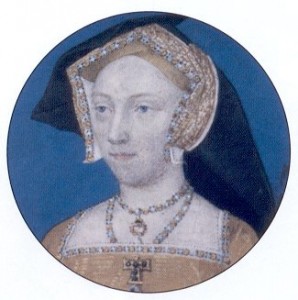
Jane had initially recovered well from her long and arduous labour, but started to go downhill in the days following Edward’s christening, suffering with a fever and delirium. On 17th October, her fever reached crisis point, and it looked like Jane would recover, but then it struck again. On the 24th October her condition worsened, and she died that night.
Here are some primary source accounts of her illness and death:
“Today the King intended to remove to Asher, and, because the Queen was very sick this night and today, he tarried, but he will be there tomorrow. “If she amend he will go and if she amend not he told me this day he could not find in his heart to tarry.” She was in great danger yesternight and to day but, if she sleep this night, the physicians hope that she is past danger. Hampton Court, xxiiiiith (sic) day of October.” Sir John Russell to Thomas Cromwell, 24th October 1537
“Yesterday afternoon the Queen had “an naturall laxe,” by reason of which she seemed to amend till toward night. All night she has been very sick, and rather “appears” than amends. Her confessor has been with her this morning, and is now preparing to minister the Sacrament of Unction. Hampton Court, Wednesday, 8 a.m.” Earl of Rutland, Bishop of Carlisle and others to Cromwell, 24th October 1537
“But Lorde what lamentacion shortly after was made for the death of his noble and gracious mother quene Iane, which departed out of this life the fourtene day of Octobre, next folowyng: and of none in the Realme was it more heauelier taken then of the kynges Maiestie himself, whose death cause the kyng imediatly to remoue into Westminster wher he mourned and kept him selfe close and secret a great while […]” Edward Hall, Hall’s Chronicle
“This yeare, the 14 of October, beinge Weddnesday, Queene Jane departed this lyfe, lyeinge in childe bedde, about 2 of the clocke in the morninge, when she had reigned as the Kings wife, beinge never crowned, one yeare and a quarter.” Charles Wriothesley, Wriothesley’s Chronicle
You will notice that both Hall and Wriothesley write of Jane dying on the 14th October, rather than the 24th, but the editor of Wriothesley’s Chronicle points out that this is an error in the transcription of the chronicles because Sir John Russell’s letter, which is still extant, is dated 24th October and also Wriothesley says that she died on a Wednesday and the 14th was a Sunday. He also points out that Cecil’s Journal gave the correct date.
Jane Seymour was buried in St George’s Chapel, Windsor Castle, on the 13th November, although her heart was buried in the Chapel Royal of Hampton Court Palace. Henry VIII chose to be buried beside the woman he regarded as his true wife, and he was laid to rest beside her after his death in January 1547.
Notes and Sources
- LP xii.ii. 970,977
- Hall’s Chronicle, p825
- Wriothesley’s Chronicle, p69-70